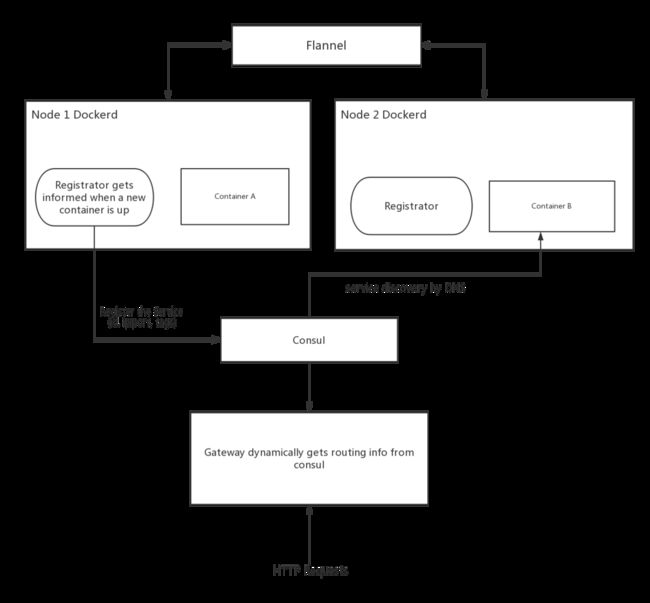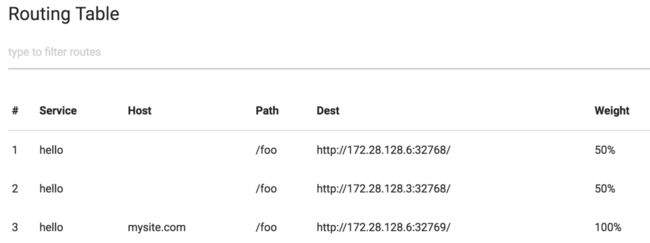在探索kubernetes的应用时,调研了几个gateway,发现fabio支持发现服务,自动生成路由,结合consul,registrator, 可以很容易的部署一套服务,比较轻量,很容易玩起来。
Start Consul
安装 consul, 如果检测到多个 private ip, 会报错,可以用 -advertise 指定一个ip.
// config.json , 指定 DNS port
{
"recursors" : [ "8.8.8.8" ],
"ports" : {
"dns" : 53
}
}
sudo docker run -d --name=consul --net=host -v $PWD/config.json:/config/config.json gliderlabs/consul-server -bootstrap -advertise=172.28.128.3
curl 172.28.128.3:8500/v1/catalog/servicesStart Registrator
启动 registrator, 因为需要调用docker api, 所以需要把docker.sock 映射到容器内部,如果你使用了tcp, 那么需要设置对应的url。
如果你希望上报容器内部ip:port, 那么需要在启动参数中加入 -internal=true, 这样注册的 Service, 都是容器内部的ip, 而port对于同一个service而言,一般是固定的,例如 一个hello服务的两个实例分别为 10.10.1.12:9090, 10.10.1.13:9090. 这样的话,就需要配置一个容器跨host的网络方案,例如 flannel, 等。 可以参考上一篇 Flannel with Docker
为了简便测试,这里就不配置flannel了。-ip是指定注册service时候使用的ip,建议要指定,选取当前机器的内网 private ip即可。我这里是 172.28.128.3.
sudo docker run -d --name=registrator --volume=/var/run/docker.sock:/tmp/docker.sock gliderlabs/registrator:latest -ip=172.28.128.3 consul://172.28.128.3:8500 Start service
启动服务,这里需要注意的是这些环境变量,作用是 override Registrator的默认值,见名知意,在 registrator 文档中有详细介绍。例如 SERVICE_9090_NAME 就是指 端口为 9090 的service 的 name。
需要注意的是 tags 这个字段,urlprefix-/foo,hello, 这里 urlprefix- 是 gateway 的一种配置,意思为 把访问 /foo 为前缀的请求转发到当前应用来。他能够匹配到例如 /foo/bar, footest, 等。如果你想加上域名的限制,可以这样 urlprefix-mysite.com/foo。 后面还有一个 hello, 作用是给这个service打一个标记,可以用作查询用。
sudo docker run -d -P -e SERVICE_9090_CHECK_HTTP=/foo/healthcheck -e SERVICE_9090_NAME=hello -e SERVICE_CHECK_INTERVAL=10s -e SERVICE_CHECK_TIMEOUT=5s -e SERVICE_TAGS=urlprefix-/foo,hello silentred/alpine-hello:v2
curl 172.28.128.3:8500/v1/catalog/services
//现在应该能看到刚启动的hello服务了
{"consul":[],"hello":["urlprefix-mysite.com/foo","hello","urlprefix-/foo"]}测试 DNS
sudo yum install bind-utils
dig @172.28.128.3 hello.service.consul SRV可以设置 /etc/resolv.conf
nameserver 172.28.128.3
search service.consul这样无论在容器内部,还是外部都可以直接解析 sevice 名, 例如:
[vagrant@localhost ~]$ ping hello
PING hello.service.consul (172.28.128.3) 56(84) bytes of data.
64 bytes from localhost.localdomain.node.dc1.consul (172.28.128.3): icmp_seq=1 ttl=64 time=0.016 ms
[vagrant@localhost ~]$ sudo docker exec -it fdde1b8247b8 bash
bash-4.4# ping hello
PING hello (172.28.128.6): 56 data bytes
64 bytes from 172.28.128.6: seq=0 ttl=63 time=0.361 msStart Gateway
前端Gateway 根据 consul中注册的 service,生成对应的路由规则,把流量分发到各个节点。 这个项目还有一个 ui 管理 route信息,端口为 9998。
创建一个配置文件 fabio.properties
registry.consul.addr = 172.28.128.3:8500在当前目录运行
docker run -d -p 9999:9999 -p 9998:9998 -v $PWD/fabio.properties:/etc/fabio/fabio.properties magiconair/fabio测试gateway:
curl 172.28.128.3:9999/foo/bar
curl 172.28.128.3:9999/foo/bar -H "Host: mysite.com"Health Check
sudo ifdown eth1
curl http://localhost:8500/v1/health/state/critical
[
{
"Node":"localhost.localdomain",
"CheckID":"service:afa2769cd049:loving_shannon:9090",
"Name":"Service 'hello' check",
"Status":"critical",
"Notes":"",
"Output":"Get http://172.28.128.6:32768/foo/healthcheck: net/http: request canceled while waiting for connection (Client.Timeout exceeded while awaiting headers)",
"ServiceID":"afa2769cd049:loving_shannon:9090",
"ServiceName":"hello",
"CreateIndex":379,
"ModifyIndex":457
}
]
sudo ifup eth1在启动 consul的时候,我们使用了-ui 参数,我们可以在 172.28.128.3:8500/ui 访问到consul的web ui管理界面,看到各个服务的状态.
对比
注册容器外IP:
每个注册的service的port都是变化的,并且因为映射内部port到了host,外部可以随意访问,私密性较弱。
注册容器内IP:
每个注册的service的port都是固定的,只能从容器内部访问。如果用 flannel,可能有一些性能损失。
DNS服务发现
查了一下如何利用DNS SRV类型来发现服务。本来以为可以用类似 Dial("hello", SRV) 的魔法, 查了一些资料貌似没有这么方便。看了下golang的net包,发现了两个方法 LookupSRV, LookupHost, 于是测试了一下,看下结果,大家知道该怎么用了吧,嘿嘿。
cname, addrs, err := net.LookupSRV("", "", "hello.service.consul")
fmt.Printf("%s, %#v, %s \n", cname, addrs, err)
for _, srv := range addrs {
fmt.Printf("%#v \n", *srv)
}
newAddrs, err := net.LookupHost("hello.service.consul")
fmt.Printf("%#v, %s \n", newAddrs, err)//output
[vagrant@bogon dns]$ go run mx.go
hello.service.consul., []*net.SRV{(*net.SRV)(0xc420010980), (*net.SRV)(0xc4200109a0)}, %!s()
net.SRV{Target:"bogon.node.dc1.consul.", Port:0x8003, Priority:0x1, Weight:0x1}
net.SRV{Target:"bogon.node.dc1.consul.", Port:0x8000, Priority:0x1, Weight:0x1}
[]string{"172.28.128.3", "172.28.128.4"}, %!s() 

